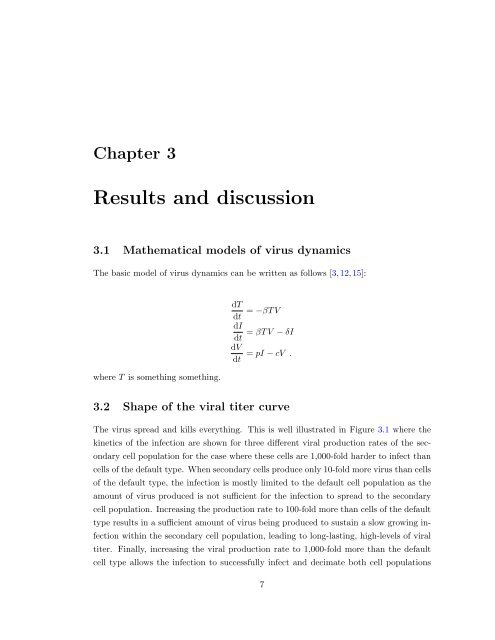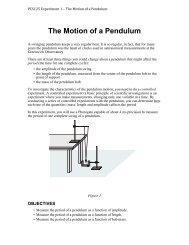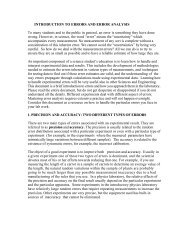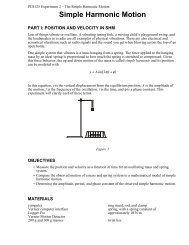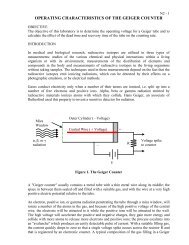the best thesis ever! and here is what happens when its ... - phymbie
the best thesis ever! and here is what happens when its ... - phymbie
the best thesis ever! and here is what happens when its ... - phymbie
Create successful ePaper yourself
Turn your PDF publications into a flip-book with our unique Google optimized e-Paper software.
Chapter 3<br />
Results <strong>and</strong> d<strong>is</strong>cussion<br />
3.1 Ma<strong>the</strong>matical models of virus dynamics<br />
The basic model of virus dynamics can be written as follows [3, 12, 15]:<br />
w<strong>here</strong> T <strong>is</strong> something something.<br />
dT<br />
dt = −βT V<br />
dI<br />
= βT V − δI<br />
dt<br />
dV<br />
= pI − cV .<br />
dt<br />
3.2 Shape of <strong>the</strong> viral titer curve<br />
The virus spread <strong>and</strong> kills <strong>ever</strong>ything. Th<strong>is</strong> <strong>is</strong> well illustrated in Figure 3.1 w<strong>here</strong> <strong>the</strong><br />
kinetics of <strong>the</strong> infection are shown for three different viral production rates of <strong>the</strong> secondary<br />
cell population for <strong>the</strong> case w<strong>here</strong> <strong>the</strong>se cells are 1,000-fold harder to infect than<br />
cells of <strong>the</strong> default type. When secondary cells produce only 10-fold more virus than cells<br />
of <strong>the</strong> default type, <strong>the</strong> infection <strong>is</strong> mostly limited to <strong>the</strong> default cell population as <strong>the</strong><br />
amount of virus produced <strong>is</strong> not sufficient for <strong>the</strong> infection to spread to <strong>the</strong> secondary<br />
cell population. Increasing <strong>the</strong> production rate to 100-fold more than cells of <strong>the</strong> default<br />
type results in a sufficient amount of virus being produced to sustain a slow growing infection<br />
within <strong>the</strong> secondary cell population, leading to long-lasting, high-levels of viral<br />
titer. Finally, increasing <strong>the</strong> viral production rate to 1,000-fold more than <strong>the</strong> default<br />
cell type allows <strong>the</strong> infection to successfully infect <strong>and</strong> decimate both cell populations<br />
7


